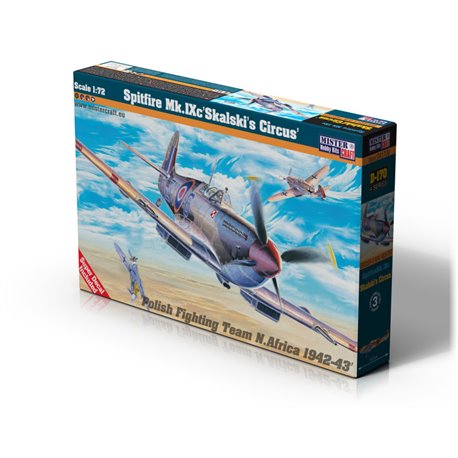No products
Spitfire Mk.IX Skalski's Circus Kit - 1:72 model kit
MCD170
New product
This product is no longer in stock
Data sheet
| Scale | 1:72 scale |
| Material | Plastic |
| Assembly | Kit |
| Finish | Unpainted |
More info
Spitfire Mk.IX Skalski's Circus 1:72
Supermarine Spitfire - British single-seat fighter built at the Supermarine factory in Southampton, England. One of the most famous fighter aircraft used during the Second World War, which was also flown by Poles.
Starting in the spring of 1943, new Merlin 63, 66 and 70 versions of the Mk IX were installed instead of the Merlin 61 engine, which had, among other things, a combat mode that made it possible, by increasing the engine's boost, to increase its power significantly for five minutes, which could, for example, allow it to break away from the enemy. (a total of 1255 machines of this variety were built), with the Merlin 66 engine as the LF.IXC (the most numerous variety produced, 4010 machines), and with the Merlin 70 engine, optimised for high-altitude operations, the HF.IXC (410 units). All version IX machines produced at the time had a C-wing with 2 20 mm guns and 4 km 7.7 mm guns.
Polish Fighting Team (PFT) - a Polish unit, also known as the ‘Skalski's Circus’ (after its commander), which took part in fighting in the 1943 North African campaign during the Second World War.
During the ongoing fighting in North Africa in January 1943, the German 5th Panzer Army rejected the Allied forces in central Tunis to the west and, under their cover, German and Italian troops retreated from Tripolitania. The Allies reorganised their troops. General Harold Alexander, commander of the 18th Army Group, became the Allied commander. They planned to conduct defensive operations. The command of the Axis forces: the German 5th APanc and the Italian 1st Army intended to beat the Allies in central Tunis. In February 1943, the German-Italian troops drove the Allies back towards the Algerian border).
In view of the impending Allied invasion of France, there was a need for experience of the interaction between ground forces and aviation. At the time, North Africa was the only theatre of operations where the interaction of ground and air forces could be tested in a future operation. At the time, it was the only place where the British Army was fighting German troops on land. After consultation, the English command chose Polish pilots for the task because the Poles fought on a better version of Spitfire fighters compared to RAF squadrons and had a lot of fighter experience).
Kit contents:
- Model aircraft
- Assembly instructions.
- Polish Air Force squadron.Polish Fighting Team,- Polish unit, also known as ‘Skalski's Circus Pilot: Stanisław Skalski, Tunisia 1943 .
- Plastic model glue with brush
Extras:
- Polish Aviation Squadron .Polish Fighting Team 145 Sq RAF.Bu Grara Airfield airbase Tunisia 1943 .
- Polish Air Force squadron .Polish Fighting Team BR195 Bu Grara Airfield airbase Tunisia 1943.
- United Kingdom Air Force Squadron RAF 72 Sq. t Souk el Khamis airbase Algeria April 1943.
- Air Force U.S.A USAF Squadron 4 Sq. 52nd pilot: Lieutenant Cabas airbase Tunisia April 1943
- U.S.A. Air Force RAF Squadron 92 Sq. tBu Grara Airfield Tunisia airbase April 1943.
- Air Force U.S.A USAF squadron 4 Sq. 12 AF USAF Corsica December 1943.





